Springboard diver Shaye Boddington lands lightly on the planet with an innovative 14-sqm tiny house (with a full height bedroom and walkway)
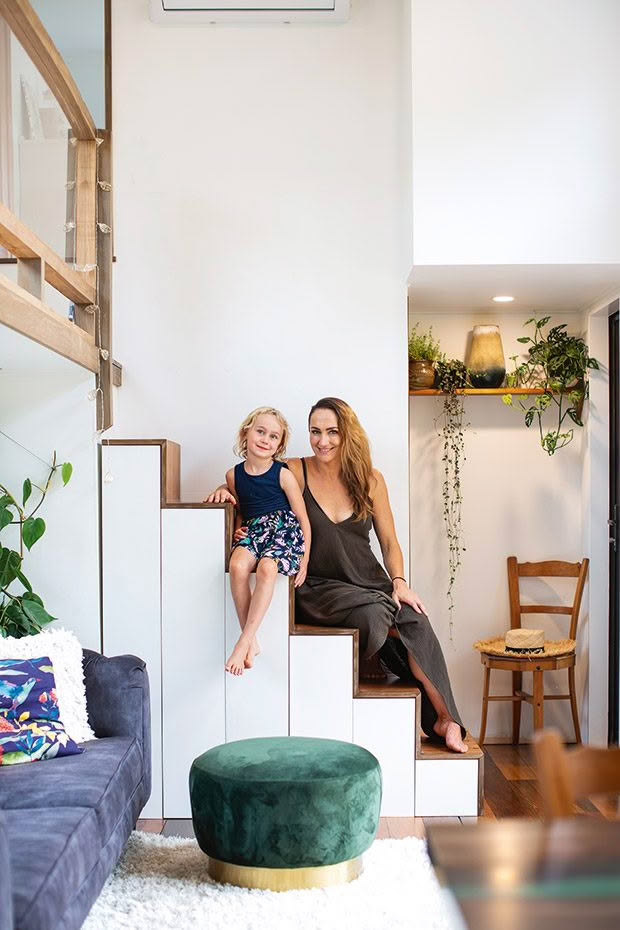
Shaye and her daughter, Hazel.
A world-class springboard diver is not only relishing a second chance at her athletic career but also hoping her tiny-homes business will have a big impact on the planet.
Words: Emma Rawson Photos: Tessa Chrisp
There’s an exact moment after diver Shaye Boddington springs from the diving board when she feels pure bliss. Gone are the wriggling nerves that preceded her dive. Even before the 2018 Commonwealth Games rep begins her climb up the slippery metal ladder to the springboard, she’s had to mentally make the butterfly nerves retreat.
She visualizes folding herself into a tight ball for a tuck, unfurling into the three and a half somersaults to follow, and then the delicate entry into the water. She explodes off the board into her dive; a beautiful whirl of athleticism that’s over in less than three seconds.
“I feel very present, and I enjoy the sensation of spinning. When I enter the water, it’s an amazing feeling of power and grace,” she says.
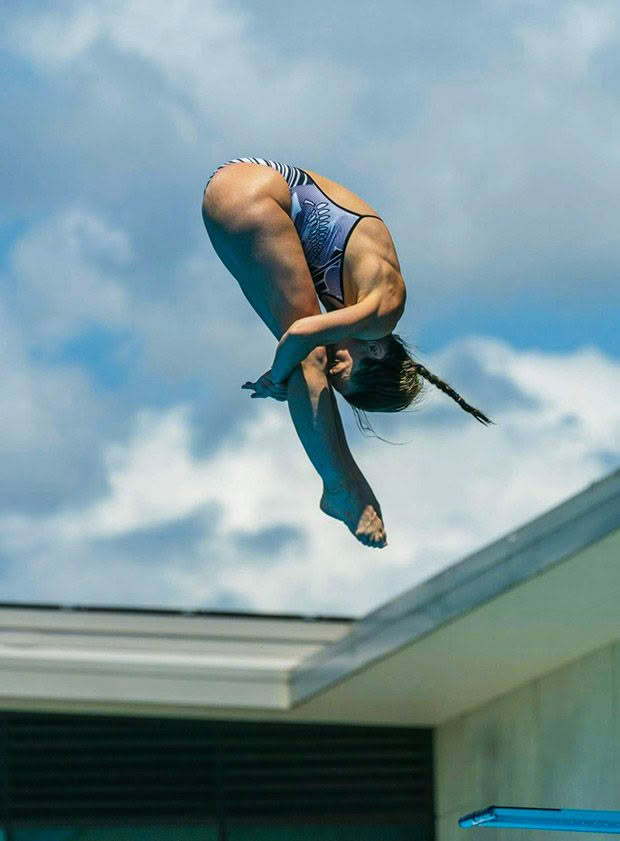
Photo: Supplied.
The judges give high scores to divers who are graceful, powerful and make small splashes as they enter the water. In her tiny home in Oratia, West Auckland, Shaye is also trying to land lightly on the planet.
The five-metre-by-2.8-metre house (plus porch) in which she and five-year-old daughter Hazel live is teeny-weeny, “unsplashy” and all they need to live comfortably. The home, built by Shaye’s company, Shaye’s Tiny Homes, is so new it smells of freshly sawn timber.
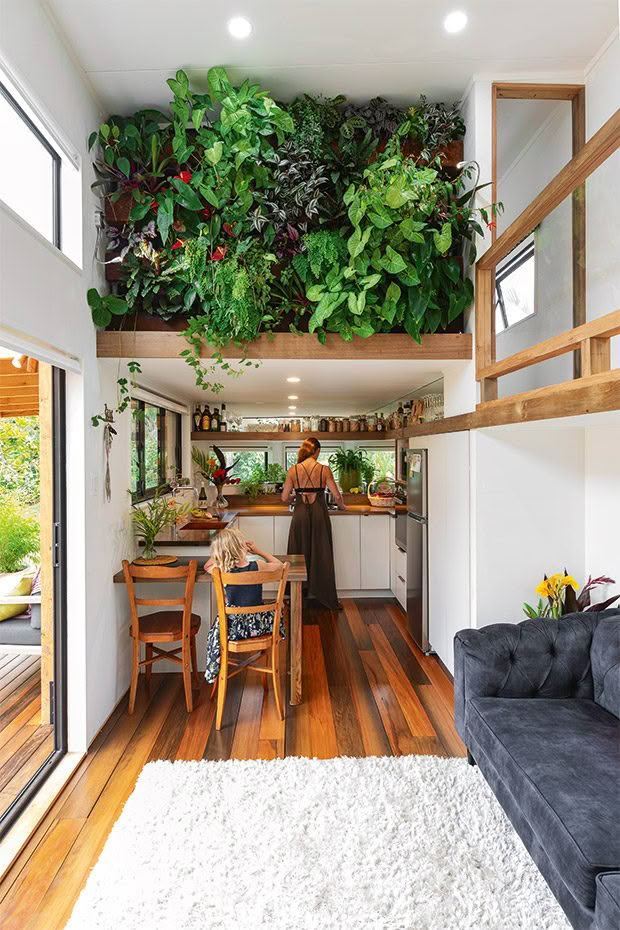
Shaye, a veteran of New Zealand’s tiny-house movement, has been living in tiny homes for six years and building them commercially (with a team of builders) for the past five. Living small has made her aware of “stuff” coming into her home.
She has rules around gifts for Christmas and birthdays: “Nothing plastic-y” for Hazel (whose nickname is Hazie) and nothing large. Gifts of experiences, such as outdoor adventures, get two thumbs-up.
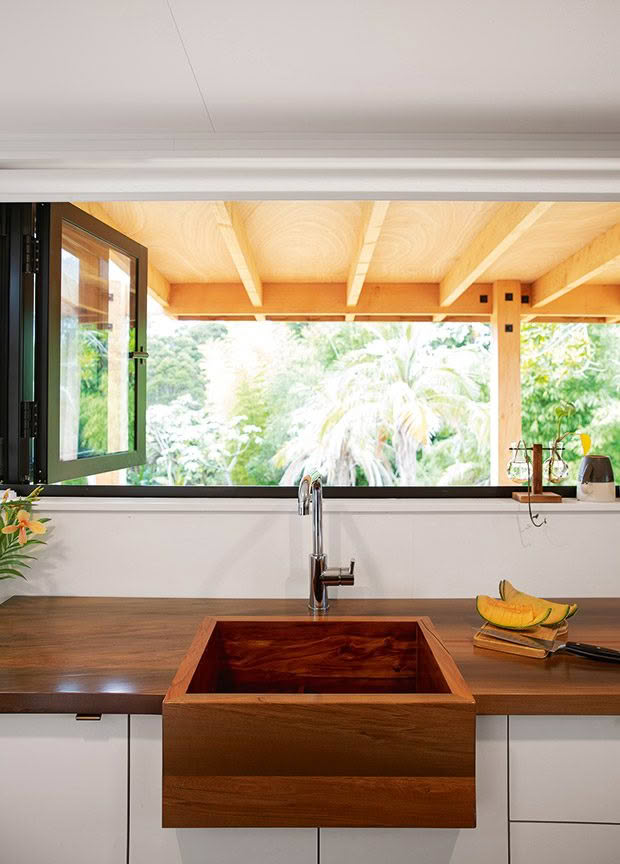
“Christmas gives me anxiety; it’s as though I can feel the landfills piling up with stuff. I’m not perfect; Santa bought a dancing unicorn for Hazel, and it broke on Christmas Day. Toys can be so fleeting. The fewer toys Hazie has in her room, the more value she places on the ones she has.
“I am quite excited to find out how growing up in a tiny house might shape her personality. I hope it helps her have gratitude and to be creative, and I want to teach her how to make a positive impact.”
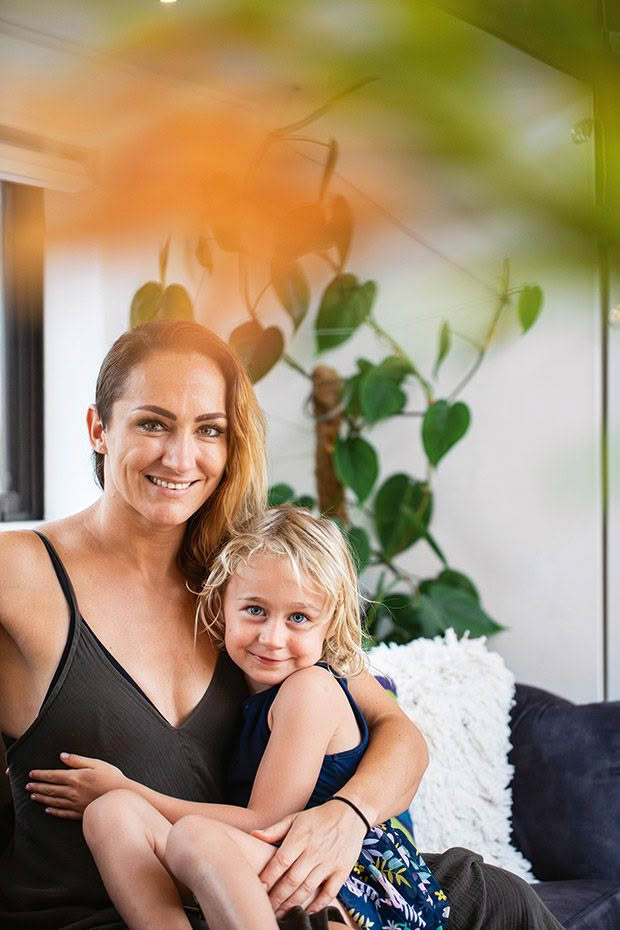
Shaye’s tiny houses sell, ready-built and including a trailer, for $110,000 to $150,000, depending on the fit-out and design. “I’m not making a killing from it, building tiny houses makes me feel like I’m making a significant difference.”
Tiny houses not only reduce consumerism, but they also offer people some financial freedom, she says.
“When you aren’t living paycheque-to-paycheque you can stop to think, ‘What do I want to do with my life?’ When people aren’t struggling, that’s when they start helping others and the community.
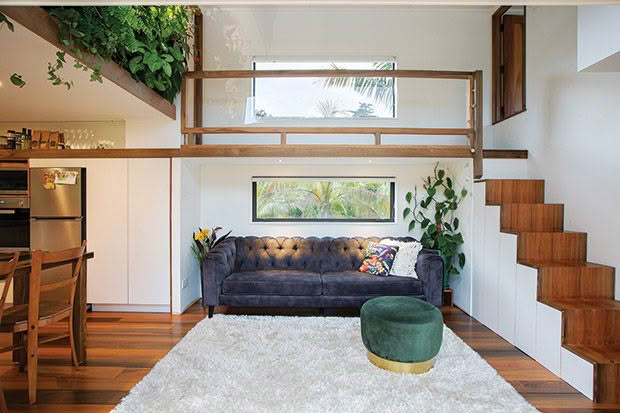
A walkway separating bedrooms is unusual for a tiny house. Shaye must walk up the stairs along the walkway and past the living wall to access her bedroom. “That journey makes the space feel a lot bigger.”
“I used to be a bit judgemental about people who didn’t look after the environment. Then I was sick during my pregnancy with hyperemesis gravidarum (severe nausea). I was so sick for nine months I didn’t care, and I stopped recycling. I realized it’s hard to care about bigger issues when you are simply surviving.”
Shaye has had her fair share of struggles. Her family fled Zimbabwe in 2002 (when she was 15) during civil unrest in the wake of Robert Mugabe’s land seizures. They arrived in Aotearoa with just five suitcases.
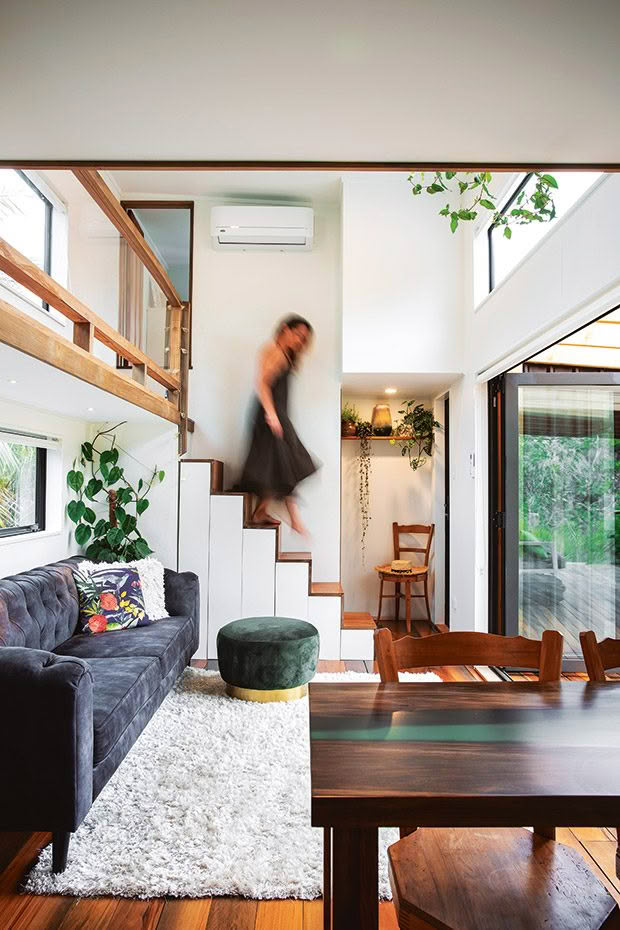
The custom-built dining table by Variant Spaces is made from river rimu and resin; the stairs in the lounge also double as storage and lead to a walkway separating Shaye’s and Hazel’s bedrooms, and avoiding the need for ladders.
She had been a champion diver in Zimbabwe and quickly made the New Zealand team. But in 2004, three months out from the Athens Olympics, she quit. An eating disorder she had been keeping secret from friends and family had left her body ravaged. The bulimia meant she would binge eat and then throw up, sometimes more than 30 times a day.
The pressure of high-performance sport was making her behaviour worse.
“I knew I couldn’t go on. I remember one night having a panic attack, not at the thought of diving but at the thought of just existing and carrying on as I was. I knew I needed to cut back on anything that was triggering my eating disorder, and getting into togs every day wasn’t helping.”
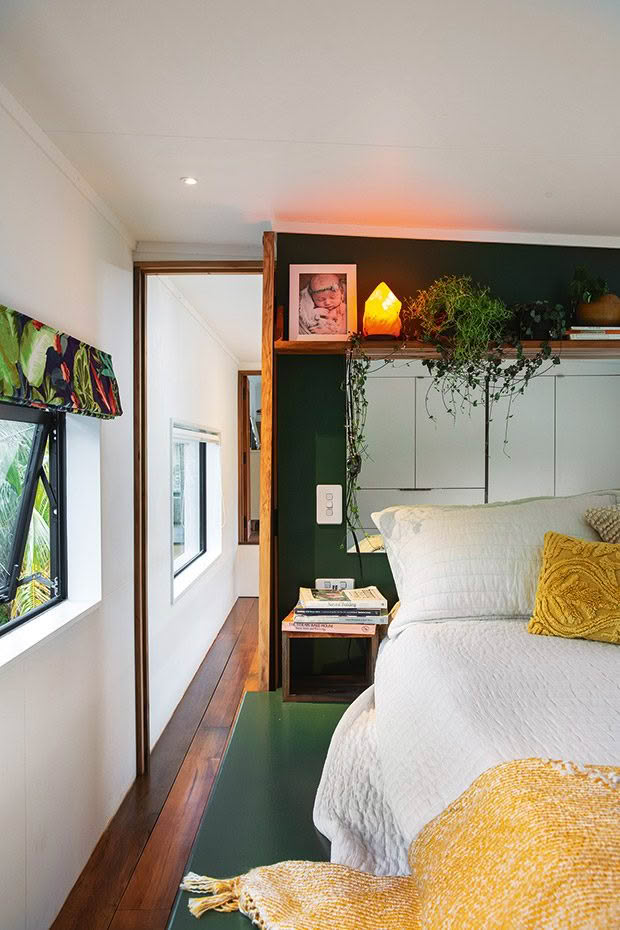
Unlike many bedrooms in tiny houses, Shaye’s is designed with a full-height ceiling, closing door and space all around the bed so that it’s easy to make.
Recovery took five years and lots of patience, persistence and work on unconditional self-love. Sharing her experiences on her blog, yourbulimiarecovery.com, has also helped. In turn, Shaye’s candid video blogs have helped many and have received tens of thousands of views and hundreds of comments.
Shaye didn’t step back on the diving board for 13 years until she wanted to show Hazel some tricks and went to the pool to try some somersaults. She was a bit rusty but was surprised at the strength of her now-healthy body.
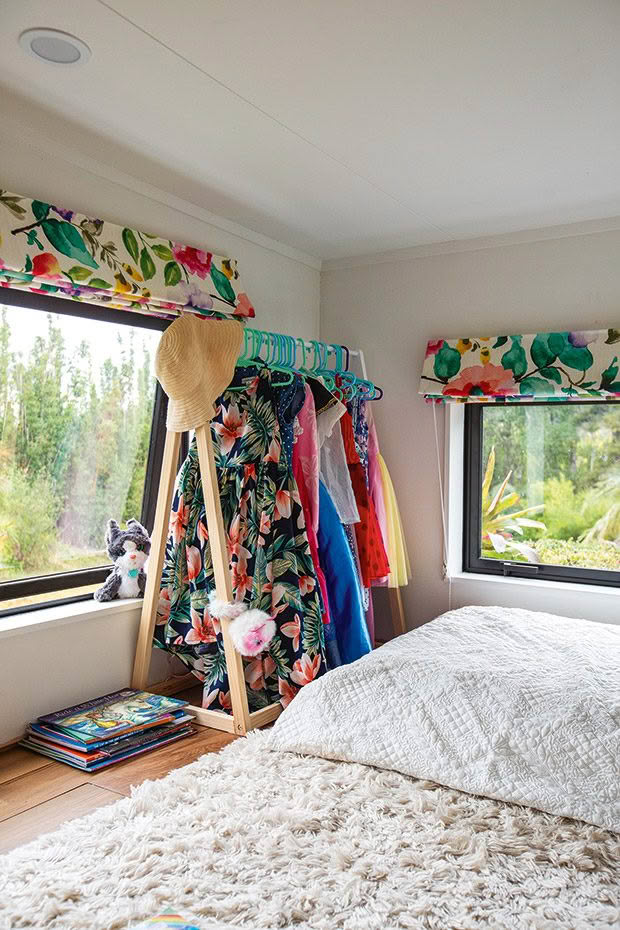
Former British coach, and then New Zealand coach, Steve Gladding, happened to catch her mucking around in the pool. He recognized Shaye, and they joked about her returning to the sport. When he spotted her at the pool a second time, he asked if she was seriously considering coming back. Within a year, the then-30-year-old mum was competing at the 2018 Commonwealth Games on the Gold Coast against athletes in their teens and twenties.
“Making the team was quite unexpected, but the memory of how to do the tricks was stored in my brain somewhere.” Shaye specializes in the one- and three-metre springboard events, but also sometimes competes in the synchronized diving.
She made the final at the Commonwealth Games and has won medals at the Oceania Championships and other international events. “I realized I love diving. Feeling strong is empowering.”
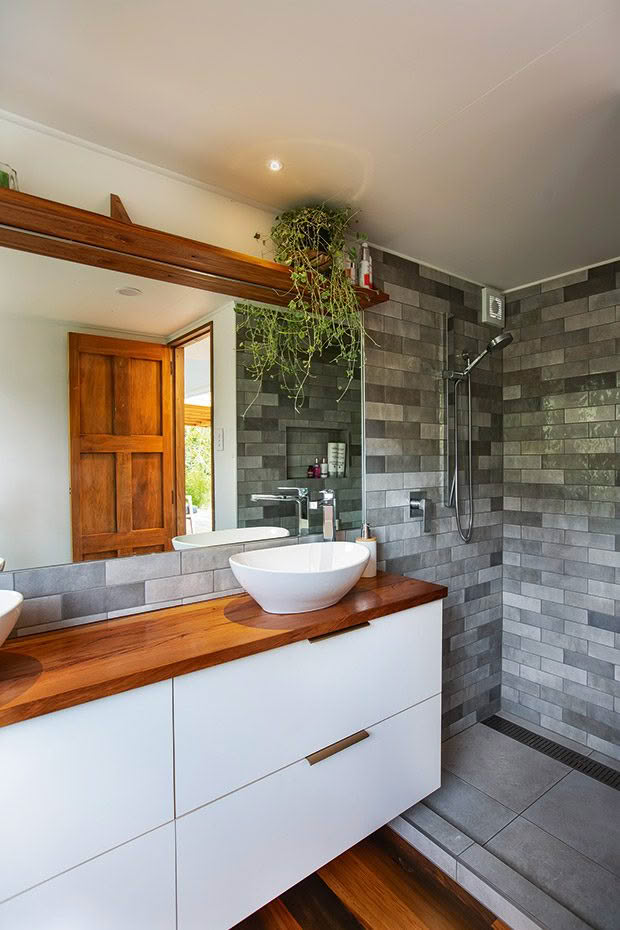
The small bathroom feels large thanks to the clever optical illusion of symmetrical sinks, a large mirror and muted tones. The “ugly parts” of the bathroom, such as the toilet and laundry basket, are tucked away.
At the time of writing, there is still a lot of uncertainty around whether the Olympics will happen next year and whether international travel for events will be allowed. The Commonwealth Games in 2022 might be a more realistic goal, she says, and training might be on the backburner for a while.
“I’m just playing it by ear, that’s all anyone can do at the moment. I feel so proud when I do represent New Zealand because there’s no other country in the world for which I’d want to compete. When we fled Zimbabwe, New Zealand was the country that took us when many other countries wouldn’t. We arrived in paradise, and I’m so grateful.”
She kept up acrobatics training in her backyard, flipping on the grass and doing handstands with Hazie since the public pool in which Shaye usually practises was shut during lockdown.
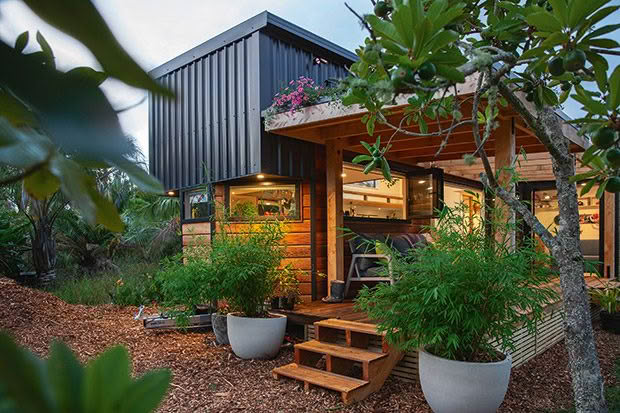
In the meantime, she is keeping up her fitness as best she can while refocusing much of her attention on establishing a tiny house and permaculture village. It’s just a concept for now, but it’s all part of her goal to lead the lightest life possible.
“There’s so much at stake now. We’re at a point of history where our leaders need to make crucial decisions. If we get it wrong, it’s my daughter’s generation who will bear the brunt of it. But I’m always the optimist, and I believe there are things we can change. The planet wants to be healthy, and nature wants to thrive and regenerate.”
INDOOR JUNGLE
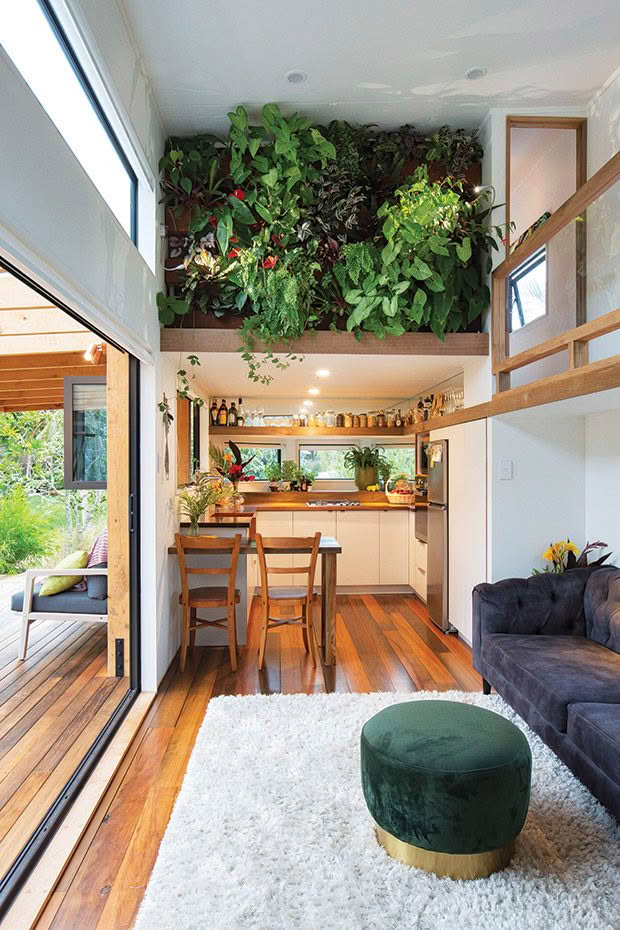
The living wall in Shaye’s lounge has many species of indoor plants including begonias, bromeliads, strawberries, podophyllum, and maidenhair ferns. She designed the wall herself; water flows in a piping system between galvanized steel gutters. The plants sit in felt pockets, which wick the water from the troughs. The hardest part was sewing the felt pockets, Shaye says.
A ROOF WITH A VIEW
Hazel and Shaye’s bedrooms both look out onto the porch, which has a living roof. “The idea was that instead of looking out onto an ugly roof; we would see unobstructed greenery plus a habitat for bees and insects.”
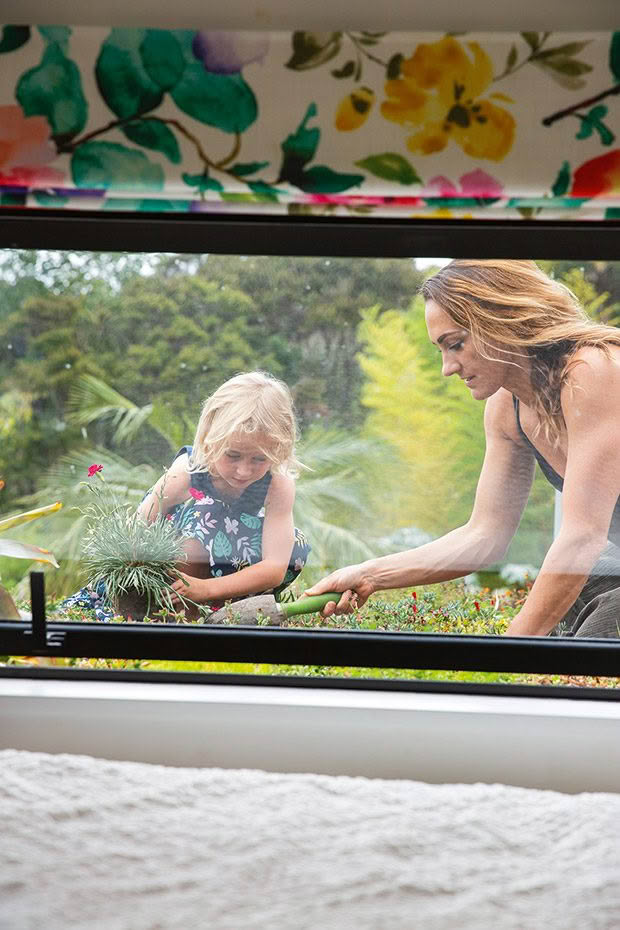
The roof surface is an EPDM rubber membrane, covered in old carpet. Ten centimetres of soil was planted with plants such as sedums, bromeliads, rock roses (Portulaca grandiflora), succulents, and petunias. The roof has a rim, so the soil doesn’t run off after rain.
TINY LIVING
Shaye completed her new tiny home in November 2019. The house is a “transportable”, meaning it is attached to a trailer and can therefore be classed as a vehicle (depending on council regulations which vary between districts). She refined the design after years of living in a tiny house with a small child.
The configuration is distinct in that there are two bedrooms (with doors or a baby gate) on the upstairs level connected by a walkway. This layout means Shaye doesn’t have to climb a ladder to check on Hazel at night. The porch and office are not attached and are on a separate transportable.
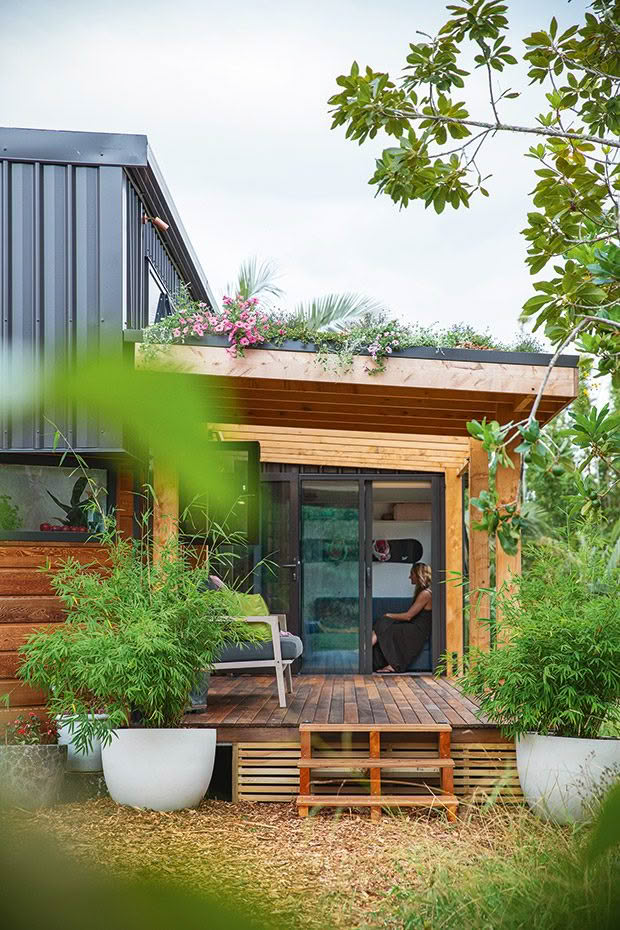
The office is a flexible space that could be an extra bedroom if Shaye were ever to have another child. “It’s essential to think about how living situations can change in the future,” she says.
Shaye and her team have built 25 tiny houses. Each is customized to meet individual needs. For instance, one owner might consider it essential to have a laundry space with a tub and sink, but for others, a bucket will suffice.
She’s also learned that every household item needs allocated storage: vacuums, brooms, ironing boards and bins. In a previous tiny-house design, she neglected to find a place for a washing basket which then had to be stored on a high shelf in the bathroom.
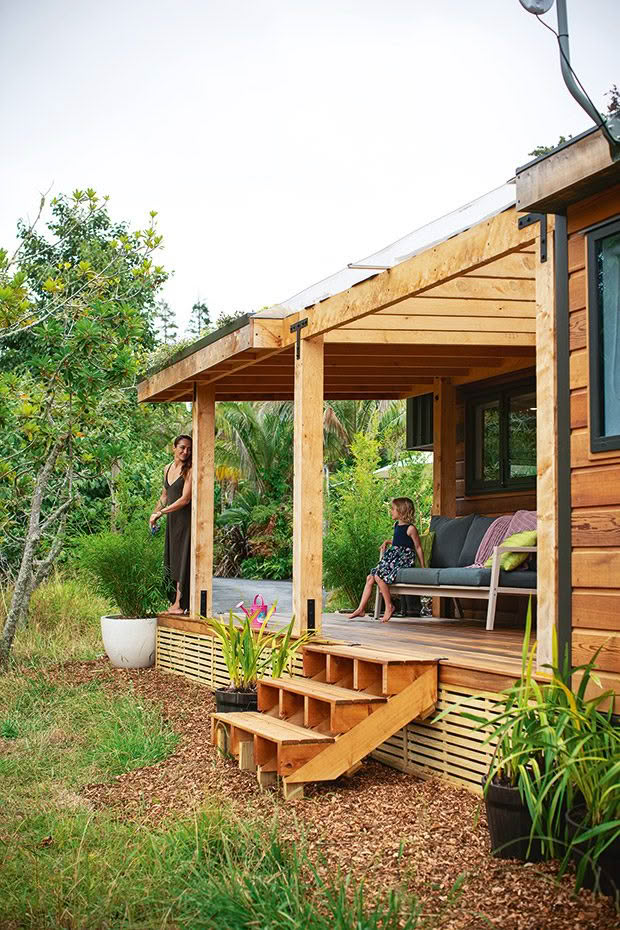
The macrocarpa porch is a transportable building and is separate from the main house.
Shaye not only builds tiny houses but sells downloadable plans through her website, shayestinyhomes.com She hopes to expand the blog section of her website to share building knowledge and will one day turn the business into a social enterprise. (She is yet to devise a business model.)
Shaye’s first attempt at building a tiny home was with her former husband, Tom. The home, called Lucy, featured in the Living Big in a Tiny House YouTube series and has had 2.3 million views. Shaye’s latest home is just down the road from Tom, who still lives in the original Lucy. shayestinyhomes.com
SPRINGING AHEAD
Springboard divers are all-around athletes; the sport requires explosive power and flexibility, with strong legs, buttocks, abdominals and arms (needed when the diver impacts the water).
Shaye trains eight hours a week in the pool practising dives, and seven hours in the gym where she does “100 sommies” — that’s 50 forward and 50 backward somersaults standing on a mat. And that’s just a warm-up.
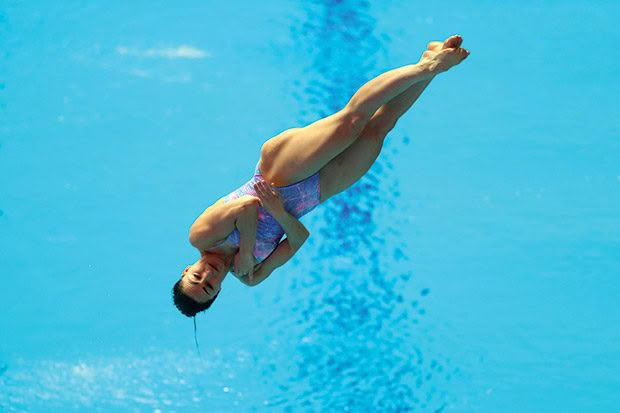
Springboard divers are scored on grace and technique. Judges consider the height and grace of a dive, the approach and the entry into the water (splash-free is the goal). Divers are raw-scored on their dive multiplied by the difficulty of the tricks. At top-level events, female divers usually do five dives, and their final score is from those five dives combined.
Shaye competes in the one-metre, and three-metre series and her favourite dive is the back-two-and-a-half in the pike position.
Read more stories like these in our special edition, Sustainability Through the Seasons, a practical guide to living a greener and more environmentally friendly life 365 days of the year.
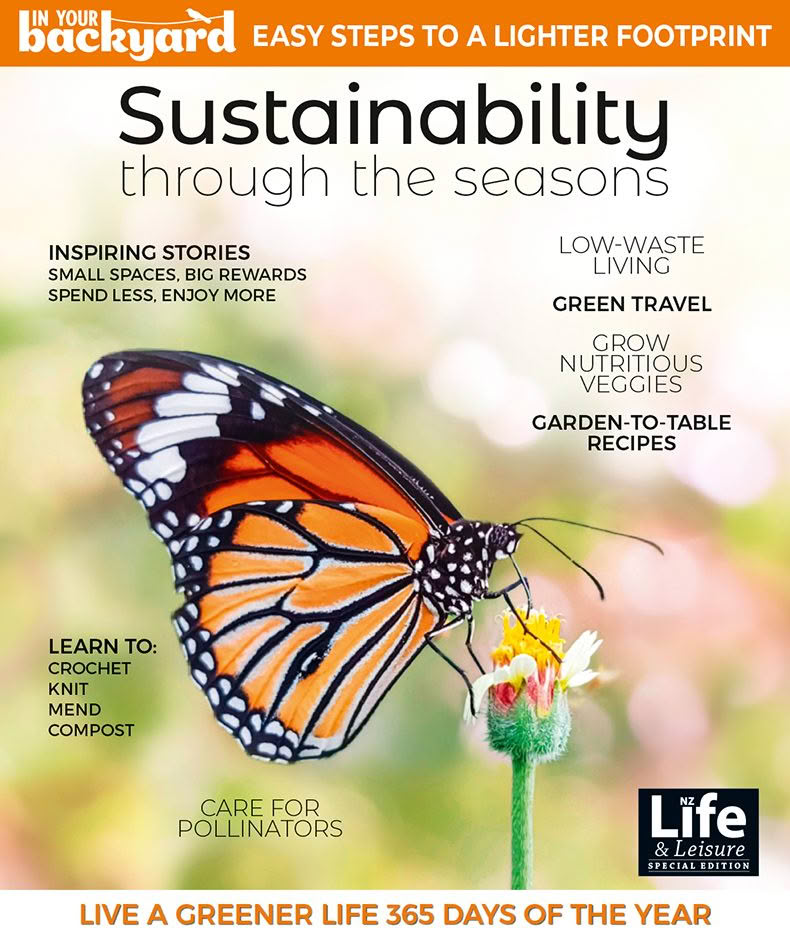
Love this story? Subscribe now!
OTHER TINY HOUSE STORIES
 This article first appeared in NZ Life & Leisure Magazine.
This article first appeared in NZ Life & Leisure Magazine.
